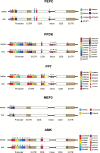Systems analysis of cis-regulatory motifs in C4 photosynthesis genes using maize and rice leaf transcriptomic data during a process of de-etiolation
- PMID: 27436282
- PMCID: PMC5014158
- DOI: 10.1093/jxb/erw275
Systems analysis of cis-regulatory motifs in C4 photosynthesis genes using maize and rice leaf transcriptomic data during a process of de-etiolation
Erratum in
-
Corrigendum.J Exp Bot. 2017 May 17;68(11):3035. doi: 10.1093/jxb/erw461. J Exp Bot. 2017. PMID: 28007949 Free PMC article. No abstract available.
Abstract
Identification of potential cis-regulatory motifs controlling the development of C4 photosynthesis is a major focus of current research. In this study, we used time-series RNA-seq data collected from etiolated maize and rice leaf tissues sampled during a de-etiolation process to systematically characterize the expression patterns of C4-related genes and to further identify potential cis elements in five different genomic regions (i.e. promoter, 5'UTR, 3'UTR, intron, and coding sequence) of C4 orthologous genes. The results demonstrate that although most of the C4 genes show similar expression patterns, a number of them, including chloroplast dicarboxylate transporter 1, aspartate aminotransferase, and triose phosphate transporter, show shifted expression patterns compared with their C3 counterparts. A number of conserved short DNA motifs between maize C4 genes and their rice orthologous genes were identified not only in the promoter, 5'UTR, 3'UTR, and coding sequences, but also in the introns of core C4 genes. We also identified cis-regulatory motifs that exist in maize C4 genes and also in genes showing similar expression patterns as maize C4 genes but that do not exist in rice C3 orthologs, suggesting a possible recruitment of pre-existing cis-elements from genes unrelated to C4 photosynthesis into C4 photosynthesis genes during C4 evolution.
Keywords: C4 photosynthesis; cell specificity; cis element; etiolation; evolution; systems biology..
© The Author 2016. Published by Oxford University Press on behalf of the Society for Experimental Biology.
Figures





Similar articles
-
Evidence for the role of transposons in the recruitment of cis-regulatory motifs during the evolution of C4 photosynthesis.BMC Genomics. 2016 Mar 8;17:201. doi: 10.1186/s12864-016-2519-3. BMC Genomics. 2016. PMID: 26955946 Free PMC article.
-
Altered expression profiles of microRNA families during de-etiolation of maize and rice leaves.BMC Res Notes. 2017 Feb 24;10(1):108. doi: 10.1186/s13104-016-2367-x. BMC Res Notes. 2017. PMID: 28235420 Free PMC article.
-
Transcriptome dynamics of developing maize leaves and genomewide prediction of cis elements and their cognate transcription factors.Proc Natl Acad Sci U S A. 2015 May 12;112(19):E2477-86. doi: 10.1073/pnas.1500605112. Epub 2015 Apr 27. Proc Natl Acad Sci U S A. 2015. PMID: 25918418 Free PMC article.
-
Finding the genes to build C4 rice.Curr Opin Plant Biol. 2016 Jun;31:44-50. doi: 10.1016/j.pbi.2016.03.012. Epub 2016 Apr 4. Curr Opin Plant Biol. 2016. PMID: 27055266 Review.
-
Getting the most out of natural variation in C4 photosynthesis.Photosynth Res. 2014 Feb;119(1-2):157-67. doi: 10.1007/s11120-013-9872-8. Epub 2013 Jun 21. Photosynth Res. 2014. PMID: 23794170 Review.
Cited by
-
Beyond the darkness: recent lessons from etiolation and de-etiolation studies.J Exp Bot. 2020 Feb 19;71(4):1215-1225. doi: 10.1093/jxb/erz496. J Exp Bot. 2020. PMID: 31854450 Free PMC article. Review.
-
The genetics of convergent evolution: insights from plant photosynthesis.Nat Rev Genet. 2019 Aug;20(8):485-493. doi: 10.1038/s41576-019-0107-5. Nat Rev Genet. 2019. PMID: 30886351 Review.
-
De novo transcriptome assemblies of C3 and C4 non-model grass species reveal key differences in leaf development.BMC Genomics. 2023 Feb 6;24(1):64. doi: 10.1186/s12864-022-08995-7. BMC Genomics. 2023. PMID: 36747121 Free PMC article.
-
Interspecific analysis of diurnal gene regulation in panicoid grasses identifies known and novel regulatory motifs.BMC Genomics. 2020 Jun 25;21(1):428. doi: 10.1186/s12864-020-06824-3. BMC Genomics. 2020. PMID: 32586356 Free PMC article.
-
C4 gene induction during de-etiolation evolved through changes in cis to allow integration with ancestral C3 gene regulatory networks.Sci Adv. 2023 Mar 29;9(13):eade9756. doi: 10.1126/sciadv.ade9756. Epub 2023 Mar 29. Sci Adv. 2023. PMID: 36989352 Free PMC article.
References
-
- Ali S, Taylor WC. 2001. Quantitative regulation of the Flaveria Me1 gene is controlled by the 3′-untranslated region and sequences near the amino terminus. Plant Molecular Biology 46, 251–261. - PubMed
-
- Aubry S, Brown NJ, Hibberd JM. 2011. The role of proteins in C3 plants prior to their recruitment into the C4 pathway. Journal of Experimental Botany 62, 3049–3059. - PubMed
-
- Aubry S, Smith-Unna RD, Boursnell CM, Kopriva S, Hibberd JM. 2014. Transcript residency on ribosomes reveals a key role for the Arabidopsis thaliana bundle sheath in sulfur and glucosinolate metabolism. Plant Journal 78, 659–673. - PubMed
Publication types
MeSH terms
LinkOut - more resources
Full Text Sources
Other Literature Sources
Miscellaneous

